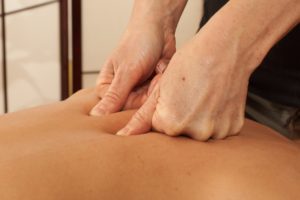
Some types of bodywork, such as Reiki or craniosacral therapy are much more subtle and work on an energetic level. They are an alternative to the more physical Swedish massage. But many other specialized techniques are easily incorporated into a Swedish massage. Dreamclinic practitioners are cross-trained in several techniques and will use them together with Swedish during a typical treatment session to tailor make a session that maximizes your massage experience.
To assist you in choosing the type of bodywork best suited for you, the most widely practiced massage modalities are described below. (There are even more modalities such as Hellerwork, Polarity or the Feldenkrais not described here). It is not necessary, although it may be helpful, for you to intimately understand the difference between all the massage modalities. What is most important is to be aware of your own goals in getting massage. You can then interview several practitioners, asking them what approach they would use to address your specific goals. If you have a condition such as whiplash or tendonitis, ask directly if the practitioner is skilled working on this condition and how they would go about it. This is the best way to ensure you will get the right type of bodywork for you.
Swedish massage – best known and most widely practiced approach to massage. It focuses on improving blood flow to the skin and muscle and removing muscle tension. Swedish provides generalized relaxation, improves circulation, lowers blood pressure, reduces stress and enhances one’s overall state of health.
Deep Tissue and Trigger Point Therapy – uses slow friction and deep finger pressure on body areas suffering from chronic muscle tension or areas that ache or feel contracted. This type of massage is useful for areas of hypertension, such as a stiff neck or sore shoulders. Deep tissue work works well in combination with traditional Swedish therapy.
Myofascial Release – All muscle is covered by a thin layer of tissue (called”fascia”) that helps maintain body posture and provides support and strength for the muscles. Fascia can tighten or become stuck in places, constricting muscle and not allowing it to fully relax. With Myofascial Release, the practitioner gently stretched fascia along the direction of the muscle until
the tissue releases and is fully elongated. The result of myofascial work is postural improvements and noticeable relaxation of cramped muscle groups.
Sports massage – Sports massage, geared toward athletes and fitness enthusiasts, is more vigorous than other forms of massage. Sports massage is used to warm up muscle tissue, assist in training, prevent injury, and aid healing in case of soreness or injury. It is used both before and after exercise, as well as in the treatment of sports injuries such as sprains, strains, or tendonitis.
Reiki – Reiki is a form of energy work. It uses a series of hands-on holding positions that correspond to vital organs and nerve plexes to assist the body’s own recuperative processes and restore mental calm. Reiki is excellent for those with anxiety or mood disorders. It is also gaining favor with cancer patients. Reiki works at the deepest levels of the body and is extremely relaxing.
Reflexology – Reflexology is based on the concept that all the organs of the body are mapped to our feet (and hands). Reflexology applies finger pressure, some stretching and movement to pressure points on the feet with the goal of promoting healthy functioning of the body’s various organs.
Shiatsu – This is a Japanese form of bodywork that is rooted in the same principles of Traditional Chinese Medicine as acupuncture. Both see the body as an interconnected web of energy pathways called meridians. Blockages to flow of energy results in imbalances: some areas have an excess of energy and others a deficiency. These blockages lead to tension, pain, and diminished health. The Shiatsu practitioner uses a combination of pressure, stretching, and holding key points to treat these blockages and restore a smooth flow of energy and balance in the body.
Lymphatic Massage – A very light, gentle, repetitive stroke is used to stimulate the activity of the lymphatic system where there is edema. Lymphatic massage is used to reduce swelling resulting from injury or post-surgery.
Heated Stone Massage – For these treatments, the therapist uses heated basalt mineral stones and/or semi-precious stones that represent the chakras. Muscle tension is released as the smooth stones move over the muscle. Heated Stone Massage is also thought to align subtle energies within the body for greater attunement and harmony.
Craniosacral Therapy (CST) – Craniosacral therapy monitors the rhythm fluid that is continuously draining and refilling around our brain and spinal cord. By monitoring the craniosacral rhythm, the therapist discovers where healing is needed and corrects the sources of pain using extremely subtle manipulative techniques. CST is an extremely gentle hands-on technique that causes deep relaxation for the client.
Rolfing – Rolfing is a system of body restructuring and movement education. It works with the deep myofascial structures of the body in order to release fascial adhesions and allowing the muscles and bones to return to balanced relationships. The focus is on alignment throughout they body – legs, torso, arms, etc… You may want to research more into Rolfing if you have serious postural deviations.
Pregnancy – Pregnancy massage is designed to decrease tension and swelling and increase circulation for both pregnant women and those who have just given birth.
